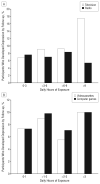Association between media use in adolescence and depression in young adulthood: a longitudinal study
- PMID: 19188540
- PMCID: PMC3004674
- DOI: 10.1001/archgenpsychiatry.2008.532
Association between media use in adolescence and depression in young adulthood: a longitudinal study
Abstract
Context: Although certain media exposures have been linked to the presence of psychiatric conditions, few studies have investigated the association between media exposure and depression.
Objective: To assess the longitudinal association between media exposure in adolescence and depression in young adulthood in a nationally representative sample.
Design: Longitudinal cohort study.
Setting and participants: We used the National Longitudinal Survey of Adolescent Health (Add Health) to investigate the relationship between electronic media exposure in 4142 adolescents who were not depressed at baseline and subsequent development of depression after 7 years of follow-up. Main Outcome Measure Depression at follow-up assessed using the 9-item Center for Epidemiologic Studies-Depression Scale.
Results: Of the 4142 participants (47.5% female and 67.0% white) who were not depressed at baseline and who underwent follow-up assessment, 308 (7.4%) reported symptoms consistent with depression at follow-up. Controlling for all covariates including baseline Center for Epidemiologic Studies-Depression Scale score, those reporting more television use had significantly greater odds of developing depression (odds ratio [95% confidence interval], 1.08 [1.01-1.16]) for each additional hour of daily television use. In addition, those reporting more total media exposure had significantly greater odds of developing depression (1.05 [1.0004-1.10]) for each additional hour of daily use. We did not find a consistent relationship between development of depressive symptoms and exposure to videocassettes, computer games, or radio. Compared with young men, young women were less likely to develop depression given the same total media exposure (odds ratio for interaction term, 0.93 [0.88-0.99]).
Conclusion: Television exposure and total media exposure in adolescence are associated with increased odds of depressive symptoms in young adulthood, especially in young men.
Figures


Similar articles
-
A prospective study of screen time in adolescence and depression symptoms in young adulthood.Prev Med. 2015 Dec;81:108-13. doi: 10.1016/j.ypmed.2015.08.009. Epub 2015 Aug 21. Prev Med. 2015. PMID: 26303369
-
Associations between television watching and car riding behaviors and development of depressive symptoms: a prospective study.Mayo Clin Proc. 2015 Feb;90(2):184-93. doi: 10.1016/j.mayocp.2014.12.006. Mayo Clin Proc. 2015. PMID: 25659236 Free PMC article.
-
Television viewing and risk of sexual initiation by young adolescents.Arch Pediatr Adolesc Med. 2006 Apr;160(4):375-80. doi: 10.1001/archpedi.160.4.375. Arch Pediatr Adolesc Med. 2006. PMID: 16585482
-
Social Media Use and Depressive Symptoms During Early Adolescence.JAMA Netw Open. 2025 May 1;8(5):e2511704. doi: 10.1001/jamanetworkopen.2025.11704. JAMA Netw Open. 2025. PMID: 40397441 Free PMC article.
-
Folic acid supplementation and malaria susceptibility and severity among people taking antifolate antimalarial drugs in endemic areas.Cochrane Database Syst Rev. 2022 Feb 1;2(2022):CD014217. doi: 10.1002/14651858.CD014217. Cochrane Database Syst Rev. 2022. PMID: 36321557 Free PMC article.
Cited by
-
The associations between screen time-based sedentary behavior and depression: a systematic review and meta-analysis.BMC Public Health. 2019 Nov 14;19(1):1524. doi: 10.1186/s12889-019-7904-9. BMC Public Health. 2019. PMID: 31727052 Free PMC article.
-
Reciprocal associations between screen time and emotional disorder symptoms during adolescence.Prev Med Rep. 2019 Jan 25;13:281-288. doi: 10.1016/j.pmedr.2019.01.014. eCollection 2019 Mar. Prev Med Rep. 2019. PMID: 30733913 Free PMC article.
-
Is change in mental distress among adolescents predicted by sedentary behaviour or screen time? Results from the longitudinal population study The Tromsø Study: Fit Futures.BMJ Open. 2020 Feb 12;10(2):e035549. doi: 10.1136/bmjopen-2019-035549. BMJ Open. 2020. PMID: 32054629 Free PMC article.
-
Analysis using national databases reveals a positive association between dietary polyunsaturated fatty acids with TV watching and diabetes in European females.PLoS One. 2017 Mar 29;12(3):e0173084. doi: 10.1371/journal.pone.0173084. eCollection 2017. PLoS One. 2017. PMID: 28355278 Free PMC article.
-
Using ecological momentary assessment to determine media use by individuals with and without major depressive disorder.Arch Pediatr Adolesc Med. 2011 Apr;165(4):360-5. doi: 10.1001/archpediatrics.2011.27. Arch Pediatr Adolesc Med. 2011. PMID: 21464384 Free PMC article.
References
-
- Lopez AD, Mathers CD, Ezzati M, Jamison DT, Murray CJ. Global and regional burden of disease and risk factors, 2001: systematic analysis of population health data. Lancet. 2006;367(9524):1747–1757. - PubMed
-
- Blazer DG, Kessler RC, McGonagle KA, Swartz MS. The prevalence and distribution of major depression in a national community sample: the National Comorbidity Survey. Am J Psychiatry. 1994;151(7):979–986. - PubMed
-
- Commission on Adolescent Depression and Bipolar Disorder . Depression and bipolar disorder. In: Evans DL, Foa EB, Gur RE, et al., editors. Treating and Preventing Adolescent Mental Health Disorders: What We Know and What We Don't Know: A Research Agenda for Improving the Mental Health of Our Youth. Oxford University Press; New York, NY: 2005.
-
- Paradis AD, Reinherz HZ, Giaconia RM, Fitzmaurice G. Major depression in the transition to adulthood: the impact of active and past depression on young adult functioning. J Nerv Ment Dis. 2006;194(5):318–323. - PubMed
-
- Reinherz HZ, Giaconia RM, Hauf AM, Wasserman MS, Silverman AB. Major depression in the transition to adulthood: risks and impairments. J Abnorm Psychol. 1999;108(3):500–510. - PubMed
Publication types
MeSH terms
Grants and funding
LinkOut - more resources
Full Text Sources
Other Literature Sources

